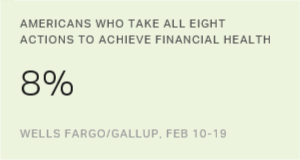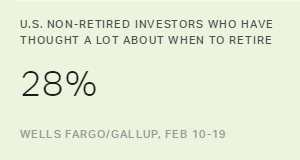Story Highlights
- Almost all investors (92%) say they pay all bills on time every month
- Barely half (52%) track all their spending by category
- Nearly one in five (19%) would have difficulty building an emergency fund
WASHINGTON, D.C. -- Majorities of U.S. investors say they are practicing each of eight financial behaviors, from 92% who are paying all of their bills on time every month to 52% who are tracking their spending by category.
| Already do | Would be easy to do | Would not be easy to do | |||||||||||||||||||||||||||||||||||||||||||||||||||||||||||||||||||||||||||||||||||||||||||||||||
|---|---|---|---|---|---|---|---|---|---|---|---|---|---|---|---|---|---|---|---|---|---|---|---|---|---|---|---|---|---|---|---|---|---|---|---|---|---|---|---|---|---|---|---|---|---|---|---|---|---|---|---|---|---|---|---|---|---|---|---|---|---|---|---|---|---|---|---|---|---|---|---|---|---|---|---|---|---|---|---|---|---|---|---|---|---|---|---|---|---|---|---|---|---|---|---|---|---|---|---|
| % | % | % | |||||||||||||||||||||||||||||||||||||||||||||||||||||||||||||||||||||||||||||||||||||||||||||||||
| Pay all bills on time every month | 92 | 7 | 1 | ||||||||||||||||||||||||||||||||||||||||||||||||||||||||||||||||||||||||||||||||||||||||||||||||
| Make regular progress toward paying down high-interest debt | 77 | 17 | 5 | ||||||||||||||||||||||||||||||||||||||||||||||||||||||||||||||||||||||||||||||||||||||||||||||||
| Contribute to savings through payroll deductions or automatic transfers | 71 | 22 | 7 | ||||||||||||||||||||||||||||||||||||||||||||||||||||||||||||||||||||||||||||||||||||||||||||||||
| Review insurance needs at least once a year | 68 | 28 | 3 | ||||||||||||||||||||||||||||||||||||||||||||||||||||||||||||||||||||||||||||||||||||||||||||||||
| Save at least 10% of income for retirement | 67 | 14 | 19 | ||||||||||||||||||||||||||||||||||||||||||||||||||||||||||||||||||||||||||||||||||||||||||||||||
| Check credit score at least once a year | 61 | 35 | 3 | ||||||||||||||||||||||||||||||||||||||||||||||||||||||||||||||||||||||||||||||||||||||||||||||||
| Contribute to emergency fund to cover three to six months of expenses | 57 | 23 | 19 | ||||||||||||||||||||||||||||||||||||||||||||||||||||||||||||||||||||||||||||||||||||||||||||||||
| Track all spending by category | 52 | 38 | 9 | ||||||||||||||||||||||||||||||||||||||||||||||||||||||||||||||||||||||||||||||||||||||||||||||||
| WELLS FARGO/GALLUP, Feb. 10-19, 2017 | |||||||||||||||||||||||||||||||||||||||||||||||||||||||||||||||||||||||||||||||||||||||||||||||||||
Results are from the 2017 first-quarter Wells Fargo/Gallup Investor and Retirement Optimism Index survey of 1,007 Americans who have at least $10,000 in investments. The eight actions for financial health correspond with Wells Fargo's "8 Rules of Thumb to Financial Health," which the bank describes as "small changes" that "can easily turn into habits that could have a big impact on your financial health."
Investors are least likely to say they are tracking spending by category, but it is not because a higher proportion say tracking is not easy. Rather, more investors perceive that saving money for a specific purpose -- for retirement in one case, for an emergency fund in the other -- is difficult than perceive this about tracking spending. For both saving measures, nearly one in five (19%) say they do not do it, "and it would not be easy ... to do."
Saving is most challenging for those with investments totaling less than $100,000.
| Assets of $100,000 or more | Assets less than $100,000 | ||||||||||||||||||||||||||||||||||||||||||||||||||||||||||||||||||||||||||||||||||||||||||||||||||
|---|---|---|---|---|---|---|---|---|---|---|---|---|---|---|---|---|---|---|---|---|---|---|---|---|---|---|---|---|---|---|---|---|---|---|---|---|---|---|---|---|---|---|---|---|---|---|---|---|---|---|---|---|---|---|---|---|---|---|---|---|---|---|---|---|---|---|---|---|---|---|---|---|---|---|---|---|---|---|---|---|---|---|---|---|---|---|---|---|---|---|---|---|---|---|---|---|---|---|---|
| % | % | ||||||||||||||||||||||||||||||||||||||||||||||||||||||||||||||||||||||||||||||||||||||||||||||||||
| Contribute to emergency fund to cover three to six months of expenses | 13 | 28 | |||||||||||||||||||||||||||||||||||||||||||||||||||||||||||||||||||||||||||||||||||||||||||||||||
| Save at least 10% of income for retirement | 14 | 24 | |||||||||||||||||||||||||||||||||||||||||||||||||||||||||||||||||||||||||||||||||||||||||||||||||
| WELLS FARGO/GALLUP, FEB. 10-19, 2017 | |||||||||||||||||||||||||||||||||||||||||||||||||||||||||||||||||||||||||||||||||||||||||||||||||||
Older Americans Less Likely to Track Their Spending, Check Credit Scores
Investors aged 65 and older are less likely than younger investors to check on their credit scores and spending habits. Forty-eight percent of the older group check their credit score annually, compared with 65% of investors aged 64 or younger. Among older investors, only 44% track all their spending by category, compared with 54% of younger investors.
On another action to monitor finances, however, older investors are about as likely (67%) as younger investors (68%) to review their insurance needs at least once a year.
Bottom Line
With investor optimism at its highest level since 2000, investors are generally willing and able to take the kinds of actions identified as important for financial health. However, there is plenty of room for improvement. Only 8% take all eight actions on the checklist, and almost seven in 10 do fewer than five.
The actions that investors are least likely to carry out fall into two broad categories: monitoring finances and saving for specific purposes. The percentages of those monitoring finances -- checking credit scores and tracking spending by category -- are driven downward by older investors, who may believe they have compiled enough experience to have some understanding of where they stand in both cases.
Among those who choose not to save for specific purposes -- not putting money into an emergency fund or not saving 10% of income for retirement -- there are obvious risks. Lower unemployment rates have reduced workers' risk of losing their jobs, but they have not erased the threat altogether, and unexpected expenses such as medical emergencies are a real possibility for most in U.S. society today.
The third of nonretired investors who are not saving at least 10% of their income for retirement could face some unhappy consequences. More than half of all retired Americans say they rely on some form of savings for either a major or a minor source of income. This lack of savings for retirement comes as a growing percentage of Americans are confident in their ability to maintain their lifestyles through this period of their lives.
Survey Methods
Results for this Wells Fargo/Gallup Investor and Retirement Optimism Index poll are based on telephone interviews conducted Feb. 10-19, 2017, on the Gallup U.S. Daily survey, with a random sample of 1,007 adults, aged 18 and older, living in all 50 U.S. states and the District of Columbia and having investments of $10,000 or more.
For results based on the total sample of investors, the margin of sampling error is ±4 percentage points at the 95% confidence level. All reported margins of sampling error include computed design effects for weighting.
Each sample of national adults includes a minimum quota of 70% cellphone respondents and 30% landline respondents, with additional minimum quotas by time zone within region. Landline and cellular telephone numbers are selected using random-digit-dial methods.
Learn more about how the Wells Fargo/Gallup Investor and Retirement Optimism Index works.




